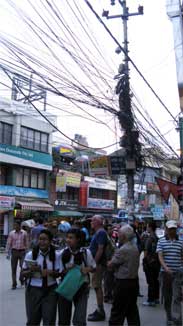|
First I want to say Kathmandu, the capital city of Nepal, is an absolutely wonderful vibrant and exciting place. In 2013, it was ranked third among the top 10 travel destinations on the rise in the world by TripAdvisor, and ranked first in Asia.
With that in mind Kathmandu can also be described as a city of organized chaos. Our ride from the airport was an eye opening experience as our driver dodged the multitude of horn blowing cars, taxis, trucks, busses, motorcycles, as well as electrical and human powered rickshaws, packs of feral dogs, throngs of people and of course the occasional cow. All the vehicles seemed to be going in random directions in order to get to their destinations. One of our drivers actually wrote a book on how to drive in Nepal. We did see some traffic lights but none of them were working. At major traffic intersections traffic was being directed by police. Is amazing that you hardly see any accidents, banged up cars or dead people lying on the streets.
We stayed in the Vaishali hotel which is in the heart of Thamel, the main tourist area. The narrow, congested and very colorful streets are flanked on both sides with hundreds of stores not only on the street level but also on second and third floors.
Surprisingly signs in Hebrew are seen all over Kathmandu. Many young Israelis travel to Nepal after their required stint in the army. About 10,000 Israelis visit Nepal each year to trek in the Himalayas.
Before we left for our trip I checked to see if there were Synagogues or any semblance of Jewish life in Nepal. Although there are very few Jews in Nepal, much to my surprise I found a very active Chabad in Kathmandu. Chabad is an Orthodox branch of Judaism that maintains a network of over 3,600 institutions in over 1,000 cities, spanning 70 countries. In April 2010 the Chabad in Kathmandu hosted 2000 people for the largest Passover Seder in the world.
 I found out that Chabad has regular Friday night services as well as a Shabbat (Sabbath ) dinner. My good friend and trek companion John (he likes to be called “Happy”) who is a Mormon, our original Hindu guide Hem (who became ill and was not able to take us on our trek) and I attended the Shabbat service and partook in a wonderful dinner. Needless to say this was quite an experience for both Happy and Hem.
Power in Nepal:
Power in Nepal is not provided on a regular basis. There are rolling blackouts for eight to nine hours each day as well as spot power outages. When this happens thousands of generators start kicking in. It takes a few minutes but power is restored thanks to the generators. The people are quite used to this. When walking in the streets no one would never know that the power supply is off except for the sounds of all the generators.
 |
|
Food:
The main dish in Nepal is Dal Bat

It seems that the Nepalese eat it at EVERY meal. “Dal” is a soup made of lentils and spices. It is served with “bhat” (rice) and vegetable curry. Accompanying it are small amounts of extremely spicy chutney and fermented pickles. Truthfully, it is delicious and I did not mind eating it frequently.
|
|
Another very popular dish is Momo. Every culture seems to have a version of this. It is a dumpling that is native to Nepal which is typically filled with vegetables although they also can be filled with pork, chicken or goat meat.
|
|
When we were in Kathmandu we did not limit ourselves to just Nepalese food, since there were so many wonderful ethnic restaurants to choose from. One of our favorites turned out to be a wonderful Middle Eastern vegetarian one called OR2K (http://www.or2k.net). We actually liked it so much that we are there twice.
Next: Highlights of Kathmandu
|
|
| |
|
|

